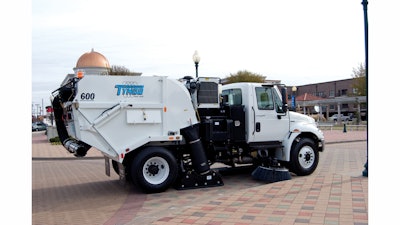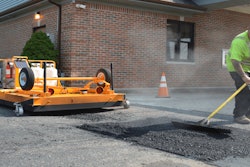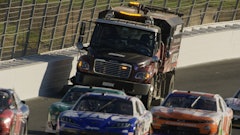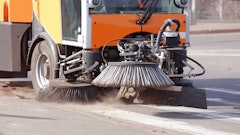
It is quite possible that no segment of the pavement maintenance industry has been more damaged over the past 10 years than the contract sweeping business. What was once an accepted and in many cases welcome service relied on by property managers and city officials has become viewed as an unnecessary evil of which buyers have both cut back and forced prices down.
The cutbacks in number of sweeps are a direct result of the Great Recession when property owners and managers lost tenants, reducing the dollars available for regular property maintenance. Sweeping prices were cut partly as a result of the Recession, but more importantly the advent of third-party providers made a huge impact on sweeping price, effectively devaluing the service.
But sweeping has value. Whether sweeping streets and highways or parking lots, contract sweeping fulfills a variety of needs for property managers and communities alike.
The Impact of Curb Appeal
One of the most persuasive arguments for sweeping is that the pavement and the property look better than streets or parking lots that are dirty and full of trash. Property managers know that a clean property is an inviting one, that properties are judged based on curb appeal, and that communities are deemed more “livable” when streets are kept clean.
“Your company’s curb appeal goes a long way toward winning customers and growing revenue,” according to CharlotteBusinessResources.com. “Even if you’re not a retail business your curb appeal sends a message to passers-by about the quality of your work. Your business appearance projects an image to potential customers and local residents making them more or less inclined to visit or otherwise support your business.
“Take a look at your parking area,” CharlotteBusinessResources.com continues. “You’ll want ample, convenient parking on a paved lot with clear markings. Lots should be well-maintained; potholes should be fixed and faded lines should be repainted. If you’re located in an urban area with lots of asphalt and no trees, consider adding tree islands and evergreen shrubs. This can make a huge impact on your curb appeal while at the same time improving the environment. Remove grass that invariably grows in cracks next to curbs and sidewalks as well as in parking lots.”
Keith Flores, vice president of business operations at Sunrise Management & Consulting and an Institute of Real Estate Management (IREM) Accredited Residential Manager (ARM), says that advice applies basically to all properties.
“If you’re a prospective resident looking for an apartment, a prospective commercial tenant, someone coming to a property to shop or for a meeting at an office and you have to dodge litter, potholes or there are weeds growing out of cracks and you can’t tell where to park because the stripes have worn off, your impression is that the property isn’t well maintained,” Flores says. “Your decision to do business there may be already be made before you even meet the person you needed to.”
“This is why one of the primary responsibilities of a maintenance team is the [HOA] community’s curb appeal, as this is often the first impression that potential residents will have when seeing the community,” says Paul Rhodes, national maintenance and safety instructor at the National Apartment Association (NAA) Educational Institute.
A Morpace Omnibus survey of 1,000 consumers, as reported on retailcostomerexperience.com in 2011, asked consumers how much of an impact a retail store's appearance (from the street) has on their decision to go in. In other words, is "how the place looks" as important as level of service, or cost?
“The results indicated that physical appearance does matter – significantly,” the survey reported. “And it suggests that retailers in all industries from automotive to restaurants to big-box should focus on the external presentation of their building to ensure there are satisfied customers inside.”
In addition, more than two-thirds of consumers said they have avoided a place of business based on its external appearance. “Consumers decide whether or not they will shop at your store based on its presentation from the street.”
And 52 percent of consumers “have avoided a business altogether because it looked dirty from the outside. These consumers form an opinion of a business based on physical presence, which heavily influences their decision to shop at a location. Nearly all shoppers (95 percent) say that exterior appearance is important in their selection of a place to shop.”
Another study performed by M/A/R/C Research and National In-Store included responses from 6,400 in-store audits as well as over 30,000 shoppers. In-store audits evaluated the appearance of store’s parking lots, litter in the store, lighting and restrooms.
“Clearly cleanliness is an important component of the consumer experience. It impacts consumers’ willingness to shop at a given retailer and also influences frequency of shopping and the length of time consumers are willing to shop. All of this has a direct impact on the amount of spending a retailer can capture,” said Randy Wahl, senior vice president at M/A/R/C Research. “While the tendency is to focus on the potential loss of a customer, an equally important concern is the broader impact that cleanliness and other aspects of the overall consumer experience have on frequency of shopping and the amount of time or scope of their shopping.”
Chapter 5 of the Green Building Operations and Maintenance Manual gets even more specific. “Sweep the parking lot surfaces weekly to remove dirt and smaller trash not collected in receptacles. Clean up spills of vehicle fluids, such as grease, oil or antifreeze with the appropriate media (e.g. towels, wipers, absorbents) and dispose of them properly… Remove trash regularly to prevent overflowing receptacles, litter problems, blocked drains, pests and vehicle and pedestrian hazards. Trash generally should be removed daily, but may be removed less often based on actual receptacle usage or by adding additional capacity.”
Safety and Liability
Regular sweeping also can improve safety and protect properties from lawsuits. Depending on what part of the country you live in, a trip over a pebble in the pavement on your property could mean a lawsuit.
“Maintaining a pavement surface is not only good for a community’s appearance, but it also lets the residents know that you care,” says Lannon Quintana, maintenance manager at Holland Partner Group. Quintana and his facility received the 2014 Maintenance Mania National Champion Award from the National Apartment Association (NAA). “Maintaining the pavement is good for our community and our residents’ homes. No one wants to see a resident get hurt.”
Quintana says Holland Partner Group determines the sweeping schedule not by pavement age but by how much traffic is on the pavement, how it’s holding up, how much money they are putting into the surface to maintain it and if any major safety concerns have come up. “Safety and aesthetics are not a measured on a time table,” he says. “Safety is always my main concern and you can’t put a price on preventing injuries.”
Sweeping as Pollution Control
One of the most underrated reasons to sweep, but arguably the most important, is the impact sweeping can have on storm water runoff. The Environmental Protection Agency (EPA) set up the National Pollutant Discharge Elimination System (NPDES) Storm Water Program to protect the country's waterways from pollution, and the agency developed a number of Best Management Practices (BMP) that should be included in such a program. Sweeping is considered a BMP.
Numerous studies have determined that sweeping pavements can be an effective method of improving the quality of water that runs off into catch basins during storms. Most of the studies reference sweeping of streets, but some are specific to parking lot sweeping and either way the generalizations and conclusions reached for either type of pavement apply.
It’s true that some studies have determined that sweeping is not effective at reducing pollutants in water storm water runoff, but most of those older studies relied on mechanical broom sweepers and regenerative air, vacuum and even mechanical/vacuum units perform better today. In addition, there are so many variables to test and consider that a survey of the research – along with a survey of recommendations of a variety of pollution-control plans – demonstrates that there is general acceptance of pavement sweeping as a reliable method of improving water runoff quality.
“Characteristics of Parking Lot Runoff Produced by Simulated Rainfall,” published by the Southern California Coastal Water Research Project, is one such study that reaffirmed studies conducted in the 1980s using mechanical broom sweepers. However, the report notes that “studies conducted in the Pacific Northwest by Sutherland and Jelen (1997) and reported in the Runoff Report (1998), have evaluated the use of vacuum-assisted sweepers and regenerative-air sweepers to determine an optimum sweeping frequency. These improved sweeping mechanisms removed finer street surface materials than the standard mechanical street cleaning equipment, with measurable improvements in pollutant removal efficiency obtained with a sweeping frequency once every week or two.”
And as most studies make clear, sweeping works best when it’s one among several BMP components – sweeping is termed a nonstructural component -- of a storm water management program (structural components include such methods as detention ponds and filtering devices).
But don’t take the EPA’s word for it. According to the Contra Costa Clean Water Program, street sweeping removes trash and debris from roadways and prevents potential pollutants from entering storm water conveyance systems which impacts the beneficial uses of surface water bodies (i.e., creeks, lakes, rivers, estuaries, bays and/or the oceans).
And a 2005 report on the Ramsey-Washington Metro Watershed District in Minnesota determined that as a pollution control practice, street sweeping is cost-effective when compared to structural best management practices. “As a pollution prevention or source control measure when integrated with other structural and non-structural BMPs, high-efficiency street sweeping improves water quality and reduces ongoing habitat deterioration,” the report notes. “As a pollution prevention or source control measure when integrated with other structural and nonstructural BMPs, high-efficiency street sweeping improves water quality and reduces ongoing habitat deterioration.”
A few years later in 2008 a Minnesota guide, “Resource for Implementing a Street Sweeping Best Practice,” reinforced that 2005 study result.
“Street sweeping is an accepted best management practice (BMP) for reducing pollutant loading into receiving waters. When street sweeping is combined with other treatment BMPs, water quality can be improved,” the report concludes. “While Minnesota emphasized construction of structural BMP devices, street sweeping as a nonstructural operation provides significant benefits in achieving quality not only in the receiving water, but roadway appearance, safety, potential air quality improvement and improving structural device maintenance. Implementing a street sweeping program using higher efficiency street sweepers either alone or in combination with mechanical sweepers and coupled with sweeping frequencies reflecting the amount of roadway material generated is a prudent approach for achieving quality.”
Pavement Preservation
The act of sweeping should be seen as part of a preventative maintenance program to extend the life of pavement. Pavement maintenance is all about applying the right treatment, at the right time. However, some people see sweeping as avoidable because they feel only aesthetics are enhanced by this service. That is not the case, especially if sand, or worse, water are present on any part of the pavement.
“Think of it this way: if you have sand or fines lingering on your pavement and then a 3,000-lb. car drives over it, that’s like 50-grit sandpaper wearing down your parking lot, over and over again” says Pete Phillips of Clean Sweep Chattanooga, TN.
Sweeping pavement regularly removes the tiny particles that will cause pavement to wear prematurely.
“Studies have consistently documented the increased effectiveness of street sweeping with
increasing particle size,” reports a 2008 study “Deriving Reliable Pollutant Removal Rates for Municipal Street Sweeping and Storm Drain Cleanout Programs in the Chesapeake Bay Basin.” “Typically, 69-91% of the total mass picked up by street sweepers (mechanical, regenerative air and vacuum assist) have particles greater than or equal to 250μm in diameter. Street sweepers are less effective at picking up smaller sized particles (e.g., Selbig and Bannerman 2007, Sutherland and Jelen 1997).”
And regularly-scheduled sweeping also ensures that any water that might linger after a storm gets removed before it can cause seep into cracks and damage the pavement.
“You must make sure there are no grade depressions, or water sitting in spots, as this will cause issues down the road,” Quintana says. “Water, whether seeping up from cracks or sitting in pools, is a pavement’s biggest enemy.”
Quintana and his team make sure they leave room in the budget every year for this service. Quintana’s property in Denver, for example, is swept by a professional company using a broom/vacuum sweeper on a semi-annual basis.
“Very few communities in our company actually sweep,” says Mitchell Krauss, value engineering manager for FirstService Residential. “A lot of that is because they don’t see it as an item that needs to be budgeted for.”
FirstService Residential manages 6,500 communities across North America and Krauss oversees about 2,000 of those in the Southeast region.
“A large majority of our communities have a budget allocated to roadway maintenance and they are very good at funding that line item year after year, but sweeping isn’t always included,” Krauss says.
What Your Customers Need to Know
But it should be. Contractors know sweeping is important and that it should be done regularly and it’s essential they convey that knowledge to customers and prospects.
“I just don’t think folks know the value of sweeping,” Krauss says. “Aside from the aesthetics, there should be more of an education on why street sweeping is important to preserving and maintaining roadways. It should not be seen as an avoidable expense, but a necessity.”
He says sweeping contractors in Florida have been successful conducting classes for property and homeowner association managers. Krauss says that in Florida, as in many states, managers need to earn a certain number of continuing education credits every two years to maintain their license. Companies often host educational classes that can teach them about pavement maintenance and give them CEUs.
“Managers happily sit through these courses because, A, they need the credits, but B, it’s great for them to be able to speak to these things so that when the community does have that need, they know how to be prepared and what to look for,” Krauss says.
If that approach hasn’t been working and you’ve struck out with property managers, don’t be afraid to keep trying. Ask them when they review their budget and maintenance needs so you can be prepared to come back at that time.
“Companies interested in working with us should ask to be on our bidding list and when the time comes, we’ll conduct the appropriate interviews and meetings to get to know them,” Flores says. “For us, relationships mean a tremendous amount. We look for quality work at a reasonable price. There is typically nothing more upsetting to an owner or management company than a job poorly done.”
Communities should have a good relationship with their vendors. “Working with a good partner goes a long way,” Krauss says.
Quintana adds that being honest with him about the business is a good way to get your company in the door. “Everyone has pavement—why is your service different? Why should I switch providers? Don’t just throw us a sales pitch—show us what you can do,” he says. “It’s not always about price, but about how you can help us and our property.”




![Pavement Awards 2025[main]](https://img.forconstructionpros.com/files/base/acbm/fcp/image/2024/05/PavementAwards_2025_main_.665883e4276e8.png?auto=format%2Ccompress&bg=fff&fill-color=fff&fit=fill&h=100&q=70&w=100)







![Pavement Awards 2025[main]](https://img.forconstructionpros.com/files/base/acbm/fcp/image/2024/05/PavementAwards_2025_main_.665883e4276e8.png?ar=16%3A9&auto=format%2Ccompress&bg=fff&fill-color=fff&fit=fill&h=135&q=70&w=240)







